Mongolia to Siberia
Privyet from over the Russian border in Siberia! Contrary to what some people think, Siberia is not under permanent snow and winter climes. They do actually experience summer, sometimes quite hot, and we have arrived at the start of the summer season.
 |
| Trans-Mongolian route "Ulaanbaatar-Sukhbaatar" |
Still brushing our teeth in bottled water and placing the toilet paper into the waste basket. I don’t think that will change for a while yet.
The Trans-Mongolian train trip from Ulaanbaatar in Mongolia to Irkutsk in Russia, a distance of just over 800 km, took close to 35 hours, or 2 nights and 1 full day. Train 263 stopped frequently whether at stations or in the middle of nowhere waiting for oncoming trains to pass and did not seem to go very fast. The journey requires a degree of patience as you go through 10 hours of border crossings between Mongolia and Russia (around 20 km apart), passport and customs checks, and generally sitting around for several hours on railway platforms as engines and carriages are exchanged. Luckily the weather was fine for catching up on some sun and strolling around the dismal little border town of Naushki on the Russian side.
 |
| Our Trans-Mongolian cabin |
From Ulaanbaatar station, we shared the carriage with a bunch of friendly Aussies on tour together led by a young Russian tour guide from St Petersburg. A local Mongolian man immediately attracted our suspicions as we boarded the train at UB, as he provided unwanted help with our luggage. Max blocked his entry into our compartment. We could see him communicating with his mobile phone to an accomplice on the platform. Afterwards we found out he’d been caught in the act trying to steal from one of the Aussies in the group. Not a pleasant farewell from Mongolia, but we didn’t let it detract from our wonderful countryside excursions.
Time in our compartment was spent catching up on reading, journaling, snoozing, sorting out trip photos on the laptop and snacking out of our bag of food supplies picked up from local supermarkets along the route. I couldn’t believe how hungry I felt just lounging around……more hungry than when we put in hours of hiking or sightseeing.
 |
| View from our guesthouse balcony |
When we arrived in Irkutsk, eastern Siberia's regional capital, we were whisked directly to our guesthouse, Baikal Chalet, 65 km away in the Lake Baikal township of Listvyanka. Listvyanka is a tiny place situated between the narrow space of the lakeside and the mountainside with many wooden houses decorated with colourful shutters. Green and sky blue seem to be the most favoured colour schemes. As it was explained to us, blue symbolises hope and green is for life and living. A surprise bonus with our pick-up was that it was accompanied by someone from Baikal Complex who gave the occupants of our coaster bus an entertaining commentary during the 90 minute transfer. The guesthouse where we spent the night is a four-storey high log chalet set against a hillside with views of Lake Baikal through a valley.
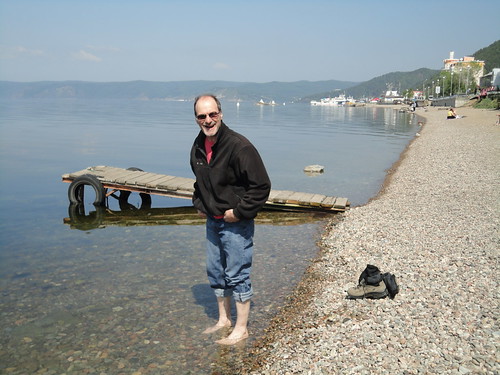 |
| Lake Baikal - bl##&y freezing! |
Seeing Lake Baikal for the first time it is hard to make out the land on the opposite side. The water stretches so far into the horizon, making it appear as if it is a sea. It is more than 600 km long, over 35 km wide and 1.6 km at its deepest point. All that apparently equates to about 20% of the world’s fresh water. Max needed encouragement to peel off his boots and socks to dip his feet into the lake’s icy cold waters for a photo moment – a tradition of ours whenever we travel to new shores.
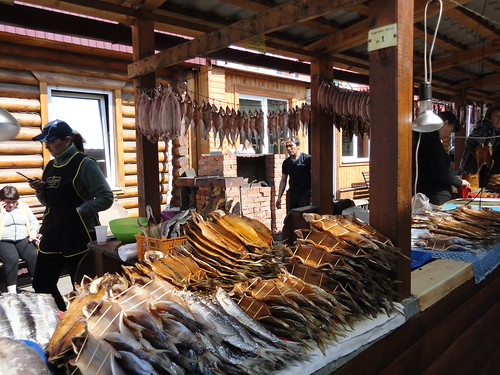 |
| Ormul fish market |
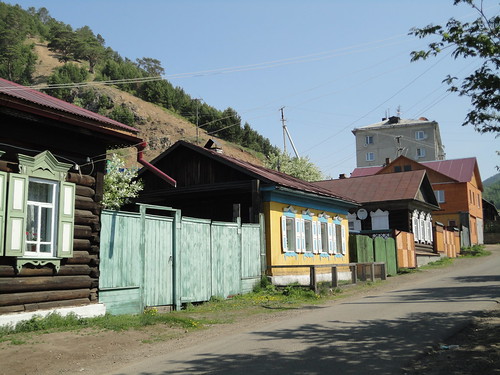 |
Wooden houses in Listvyanka
|
Listvyanka is easily explored on foot in one day as we discovered walking the 5 km one way along the lakeside to the unimpressive Baikal Museum and then the 5 km back. It’s a nice little settlement in which to chill out. If we had more time available it would have been interesting taking a boat trip out across the lake. Souvenir stalls about town sell stuffed toys of the Nerpa seal from Lake Baikal as well as wooden carved ornaments and jewellery made from Baikal agate and charoit, a purple semi-precious stone.
The local fish from this lake is the ormul fish (related to salmon) which we could smell being smoked and dried. Fillets of it hung on display around little fish stalls in the main street which also sell it out of insulated plastic eskies (coolers) that have been converted into mini smokehouses. Ormul features on just about every eating establishment’s menu here. The guesthouse’s cook and housekeeper, Tatiana, prepared us a beautiful dinner of it that night – very flavoursome.
The following morning we were again accompanied on our transfer back to Irkutsk by a young staff member who provided us with a map of the city and lots of helpful advice. We spent time exploring the city centre on foot and photographing intricately carved historic timber houses before boarding our early evening Trans-Siberian train to Moscow.
 |
| Irkutsk's main square celebrating 350 years |
 |
Beautiful filigree woodwork, Irkutsk
|
After our short but relaxing respite, we now board the train for the longest haul – the Trans-Siberian leg from Irkutsk to Moscow.









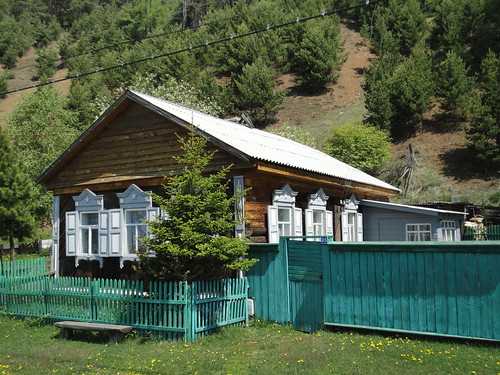
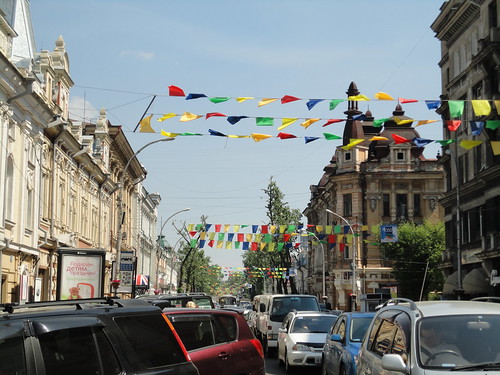
 Hi, I'm Eva - world traveller, cultural explorer and experience seeker. Together with my husband Max, we've been globetrotting for over 20 years.
Hi, I'm Eva - world traveller, cultural explorer and experience seeker. Together with my husband Max, we've been globetrotting for over 20 years.







Now 20% of the world's fresh water supply has now been contaminated by Max's stinky feet.
ReplyDelete